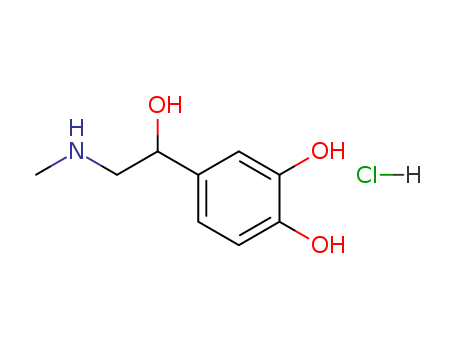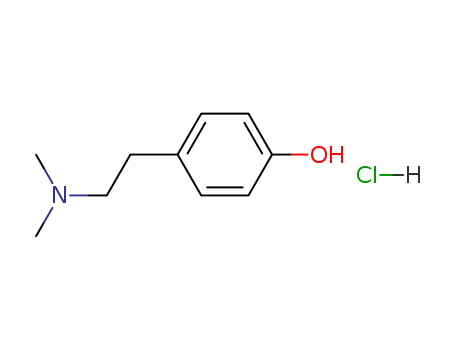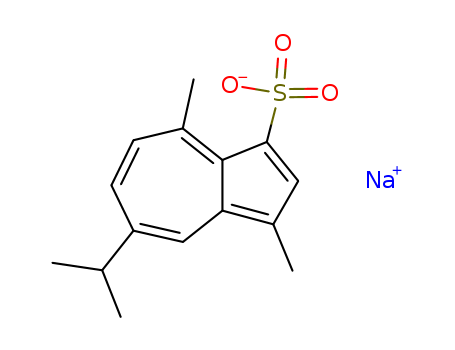
329-63-5
- Product Name:Epinephrine Hydrochloride
- Molecular Formula:C9H13NO3.HCl
- Purity:99%
- Molecular Weight:219.668
Product Details
Melting Point:157℃
Appearance:solid
Purity:99%
Chinese Factory Supply Wholesale Epinephrine Hydrochloride 329-63-5 with Cheap Price
- Molecular Formula:C9H13NO3.HCl
- Molecular Weight:219.668
- Appearance/Colour:solid
- Melting Point:157℃
- Boiling Point:413.1 °C at 760 mmHg
- Flash Point:207.9 °C
- PSA:72.72000
- Density:1.283 g/cm3
- LogP:1.54350
DL-ADRENALINE HYDROCHLORIDE(Cas 329-63-5) Usage
|
Biochem/physiol Actions |
Epinephrine improves systemic pressure during cardiopulmonary resuscitation and is used post cardiac arrest. The levels of epinephrine increases during trauma, sepsis and hypoglycemia resulting in increased cardiac rate and contractility. It is used in the treatment of acute anaphylaxis. Use of epinephrine hydrochloride enables dilation of pupil during intraocular lens (IOL) implantation surgery. |
|
General Description |
Epinephrine is one of the most commonly used agents in various settings as it functions as medication and hormone. It is a mixed α/β-adrenergic receptor agonist and stimulates these receptors. Their site of synthesis is adrenal medulla and it travels through the vascular systems. Its breakdown occurs in the central nervous system (CNS), liver and kidney. |
| Uses | Epinephrine Hydrochloride is used in emergencies to treat very serious allergic reactions to insect stings/bites, foods, drugs, or other substances. Epinephrine works quickly to improve breathing, stimulate the heart, raise a dropping blood pressure, reverse hives, and reduce swelling of the face, lips, and throat. |
InChI:InChI=1/C9H13NO3.2ClH/c1-10-5-9(13)6-2-3-7(11)8(12)4-6;;/h2-4,9-13H,5H2,1H3;2*1H/p-1/t9-;;/m0../s1
329-63-5 Relevant articles
A new and efficient route for the synthesis of naturally occurring catecholamines
Bernini, Roberta,Crisante, Fernanda,Barontini, Maurizio,Fabrizi, Giancarlo
experimental part, p. 3838 - 3842 (2010/03/30)
Catecholamines, sympathomimetic drugs an...
Pharmacokinetics/pharmacodynamics of epinephrine after single and repeat administration of neffy, EpiPen, and manual intramuscular injection
Thomas B. Casale, MD Anne K. Ellis, MD Anna Nowak-Wegrzyn, MD, PhD Michael Kaliner, MD Richard Lowenthal, MS, MBA Sarina Tanimoto, MD, PhD
Anaphylaxis, drug allergy, urticaria, and angioedema| Volume 152, ISSUE 6, P1587-1596,
The pharmacokinetic profile of neffy was bracketed by approved injection products, with a mean peak plasma level of 481 pg/mL, which fell between EpiPen (753 pg/mL) and epinephrine manual intramuscular injection (339 pg/mL). When dosed both once and twice, neffy resulted in more pronounced increases in pharmacodynamic parameters relative to EpiPen or manual injection.
329-63-5 Process route
-
carbamate](/upload/2024/8/4b23b687-9c82-4e30-a354-8a7fd242d0e0.png)
- 87697-27-6
tert-butyl [2-(3,4-dihydroxyphenyl)-2-hydroxyethyl](methyl)carbamate

-

- 329-63-5,66240-90-2
epinephrine hydrochloride
| Conditions | Yield |
|---|---|
|
With methanol; chloro-trimethyl-silane; for 3h; Reflux;
|
100% |
-

- 329-63-5,66240-90-2
epinephrine hydrochloride

-
![sodium tetrakis[(3,5-di-trifluoromethyl)phenyl]borate](/upload/2024/8/49a101be-5a7e-4d10-8c40-135b0740310e.png)
- 79060-88-1
sodium tetrakis[(3,5-di-trifluoromethyl)phenyl]borate

-
-
C32H12BF24(1-)*C9H13NO3*H(1+)
| Conditions | Yield |
|---|---|
|
In methanol; for 12h;
|
71% |
|
In chloroform;
|
329-63-5 Upstream products
-
87697-27-6

tert-butyl [2-(3,4-dihydroxyphenyl)-2-hydroxyethyl](methyl)carbamate
Relevant Products
-
Hordenine hydrochloride
CAS:6027-23-2
-
Guaiazulene
CAS:489-84-9
-
Sodium Gualenate
CAS:6223-35-4







